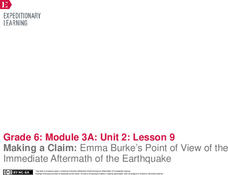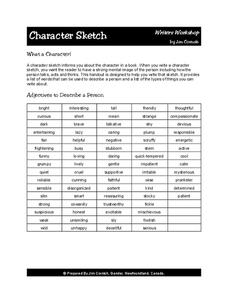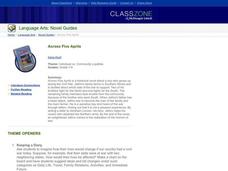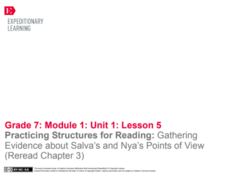National Endowment for the Humanities
Faulkner's As I Lay Dying: Form of a Funeral
Learners read and analyze William Faulkner's novel, 'As I Lay Dying.' They define Faulkner's place in American literary history, describe Faulkner's "South" in the context of the historical South and examine the Bundren family through...
EngageNY
Making a Claim: Emma Burke’s Point of View of the Immediate Aftermath of the Earthquake
Sharpen those pencils; it's time to write! Scholars begin writing the first body paragraph of their literary analysis essays. Additionally, pupils use graphic organizers to analyze a character's point of view from Laurence Yep's...
EngageNY
Making a Claim: Moon Shadow’s Point of View of the Immediate Aftermath
Body paragraphs are the building blocks of every essay. Pupils view and discuss a model essay using a rubric to evaluate one of its supporting paragraphs. Next, scholars use what they've learned to continue drafting their own literary...
Curated OER
Educator's Guide: Holes
You'll be a star at your next grade level meeting with an educational unit on Louis Sachar's Holes. Based on both the novel and film, the lessons include applications to language arts with character studies and movie reviews; social...
EngageNY
Paragraph Writing, Part II
Come up with a list of requirements for this expository essay on Esperanza's character in Esperanza Rising as a class and use the list to guide class writing. Here, learners will complete the first paragraph, discuss their notes for the...
Center for the Advancement of Ethics and Character
Charlotte's Web: A Story About Friendship
Strengthen the bonds of friendship within your class with a reading of E.B. White's award-winning novel, Charlotte's Web. Focusing on the unique characters in the story and the relationships they develop, young readers draw from their...
Curated OER
Character Sketch
For this language arts worksheet, middle schoolers use the chart of words as a tutorial for writing a formal character sketch. The words are meant to make the description more vivid.
Curated OER
Great Expectations Character Adoption
High schoolers write a detailed character analysis by adopting a character from the novel, Great Expectations, and become an authority on the character.
Curated OER
Writing Applications
Tenth graders read the novel Great Expectations by Charles Dickens and complete characterization activities. In this characterization lesson, 10th graders work in tiers to examine the text for evidence about the way Dickens uses the...
Curated OER
Across Five Aprils
Students read the novel, Across Five Aprils and investigate the theme of the individual vs, community loyalties. They keep a daily journal, role-play situations, hold a mock debate, and write a research paper on "coming of age."
Curated OER
Bio-Poem
Everyone can be a poet with this simple activity! After reading of Lucy Westerna's death, assign your class this bio poem on Professor Van Helsing. There's a specific format to follow, but it'll be interesting to see how your kids add...
Curated OER
Jacob Have I Loved: Semantic Feature Analysis Chart
Do not allow your pupils to ignore the connections among the characters in Katherine Paterson’s Newbery Medal winning novel, Jacob Have I Loved. Instead, provide them a semantic feature analysis chart that asks them to note things Louise...
Curated OER
The Adventures of Huckleberry Finn: Semantic Feature Analysis
Racist, independent, conflicted? Readers of The Adventures of Huckleberry Finn brainstorm words that describe the traits of characters in Twain’s novel and then rate these qualities in several of their favorite characters. Individuals...
Curated OER
Monster: Guided Imagery
How would you feel if you were on trial for murder—and you were only 16 years old? Put yourself in Steve Harmon's shoes before reading Monster by Walter Dean Myers. Kids listen to music that fits the theme of the book before listening to...
Curated OER
Speak: Questioning Strategy - ReQuest Strategy
The best way to analyze a piece of literature is to ask questions about the characters, plot, and theme. Encourage your learners to stump the teacher with the most difficult questions they can create using Bloom's Taxonomy and various...
Great Books Foundation
Discussion Guide for Jane Eyre
The ambiguity in Charlotte Bronte's Jane Eyre makes the novel a perfect choice for a shared inquiry discussion. Readers respond to open-ended questions with evidence drawn directly from the text.
K20 LEARN
Texture Poetry: The Great Gatsby and the Sense of Touch
To prepare for crafting a descriptive poem about a character in F. Scot Fitzgerald's The Great Gatsby, groups describe the texture of objects hidden in small bags. Individuals then select a character from the novel and an object...
Curated OER
Understanding Protagonists and Antagonists
How can you tell if a character is a villain? What about a hero? Work on literary analysis with an engaging language arts worksheet. After completing an activity about the four types of conflict, learners fill out a character map about a...
Reed Novel Studies
Sounder: Novel Study
Only one character receives a name in William H. Armstrong's novel, Sounder—the dog! With the novel study, scholars explore the author's purpose in the unusual decision. They also write similes, answer comprehension and analysis...
Infobased Learning
Bloom's Literature: How to Write about Nineteen Eighty Four
A good prompt is hard to find, especially ones that encourage application, analysis, synthesis, and evaluation of a text. Help is here in the form of a prompt list for George Orwell's Nineteen Eighty Four that offers essay topics that...
EngageNY
Practicing Structures for Reading: Gathering Evidence about Salva’s and Nya’s Points of View (Reread Chapter 3)
How does an author develop and contrast character points of view in a work of literature? Using a graphic organizer, readers continue gathering evidence about character point of view from Linda Sue Park's A Long Walk to Water. Next,...
National Endowment for the Humanities
Symbolism in Lord of the Flies
Readers of Lord of the Flies examine the four main symbols William Golding develops in his novel: the island, the conch, the Lord of the Flies effigy, and fire. Partners select one of the major symbols and create an image by adding words...
Fluence Learning
Writing About Literature: Comparing and Contrasting Characters in Heidi
Scholars read excerpts from the story, Heidi, in a three-part assessment that focuses on comparing and contrasting characters. Each part contains three tasks that challenge learners to discuss, answer comprehension questions,...
EngageNY
Establishing Structures for Reading: Gathering Evidence about Salva’s and Nya’s Points of View (Reread Chapters 1 and 2)
Readers practice gathering textual evidence to support their understanding of character point of view in A Long Walk to Water by Linda Sue Park. Working with partners, they complete a Gathering Evidence graphic organizer and engage in...

























